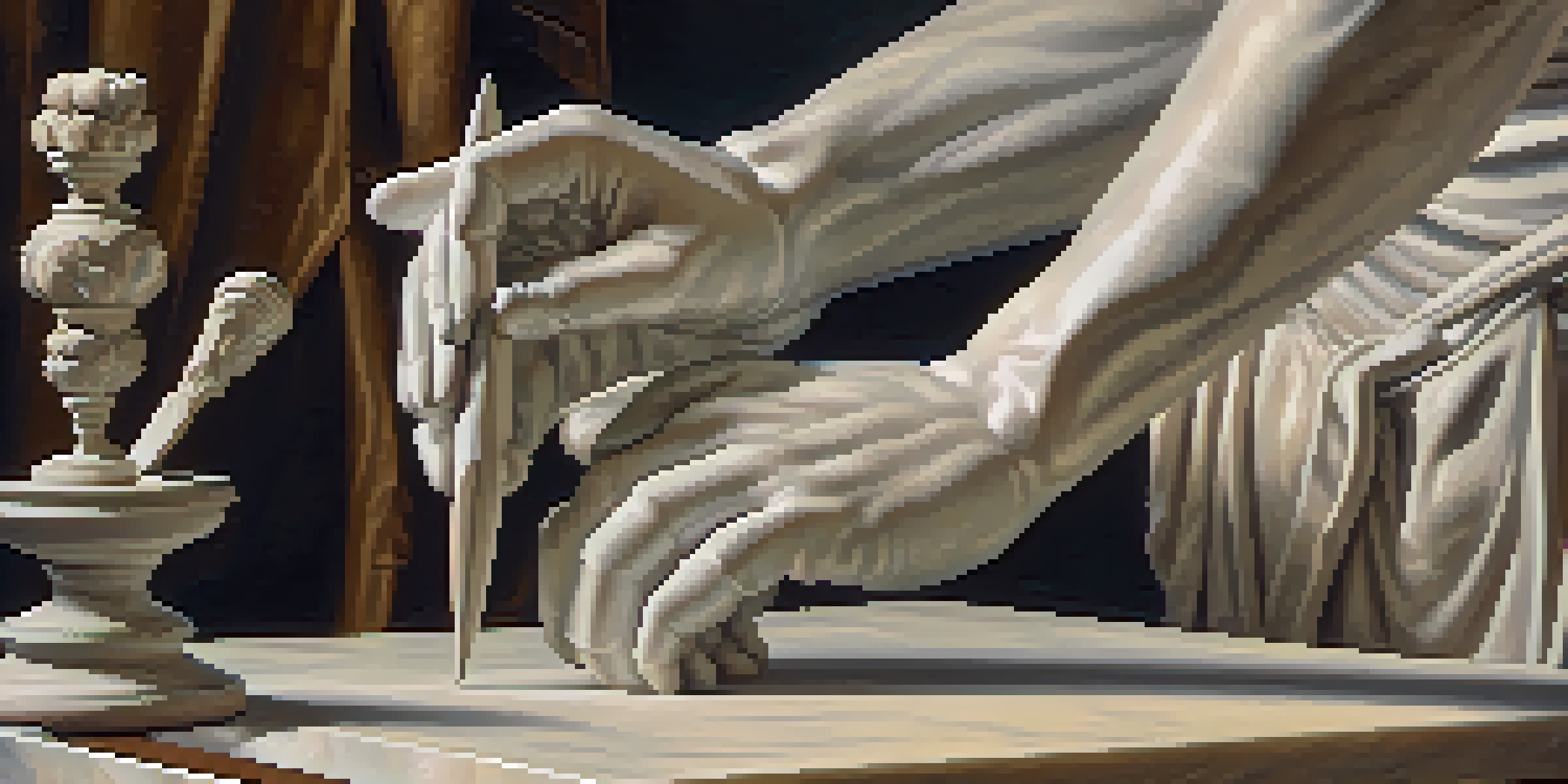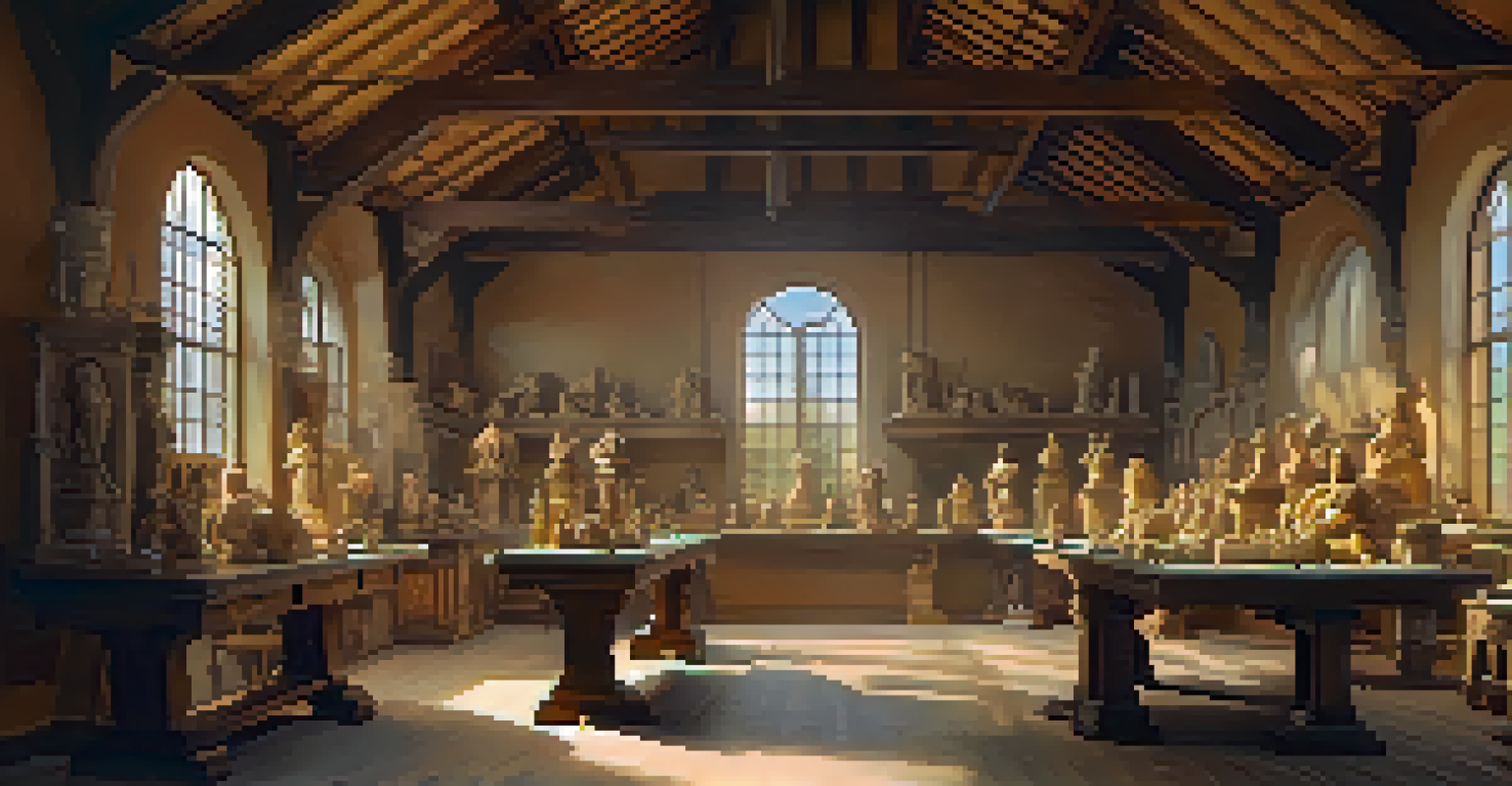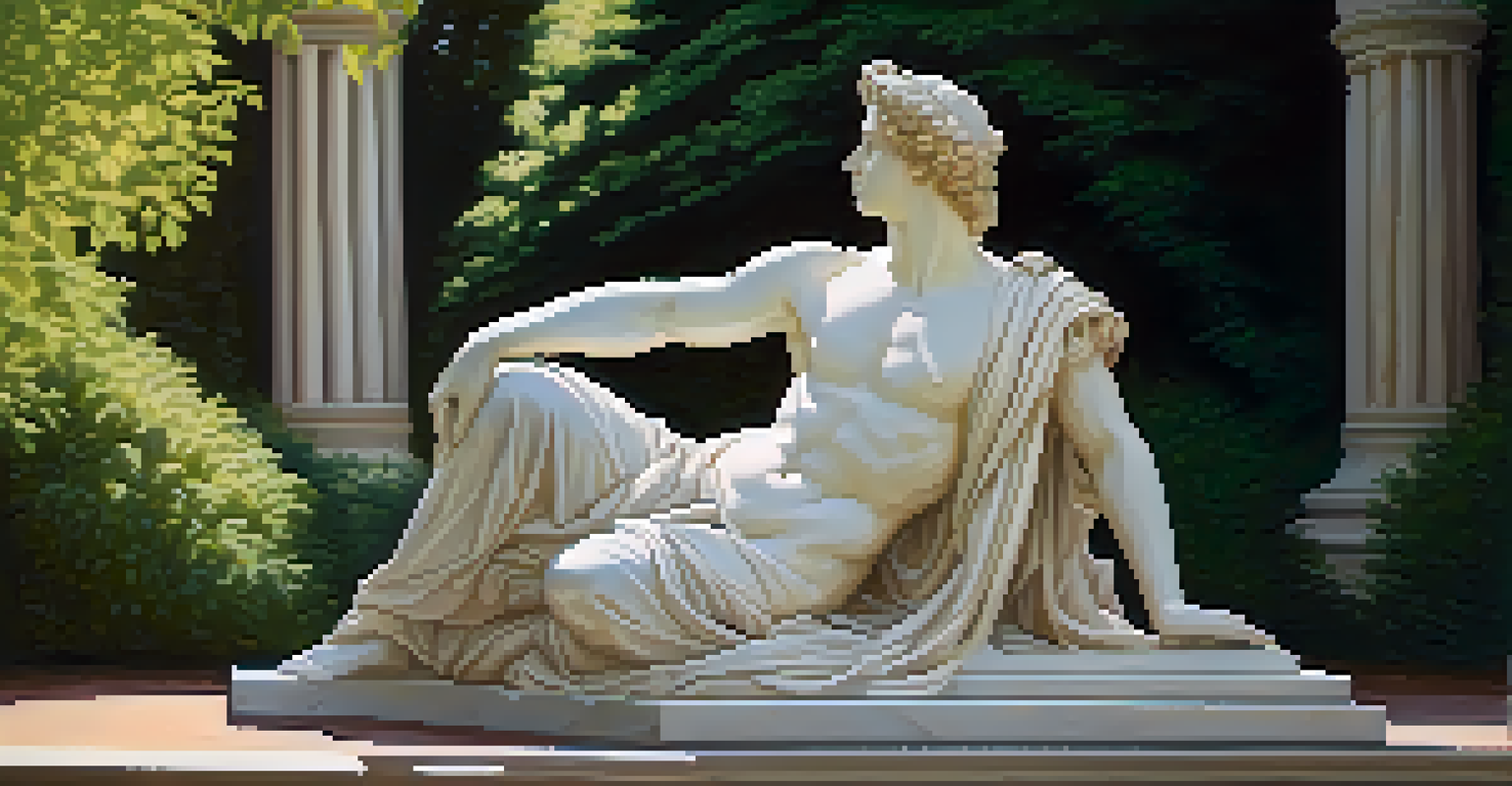The Renaissance and the Flourishing of Carving Arts

A Brief Overview of the Renaissance Era
The Renaissance, spanning from the 14th to the 17th century, marked a major cultural revival in Europe. It was characterized by a renewed interest in classical antiquity, leading to advancements in art, science, and philosophy. This era saw the emergence of humanism, which emphasized the value of human potential and achievements. As a result, artists began to explore more realistic representations of the human form and nature, setting the stage for innovative carving techniques.
Art is the most beautiful of all lies.
During this time, the art of carving became a prominent medium for expressing the new ideals of beauty and realism. Artists like Donatello and Michelangelo pushed the boundaries of traditional sculpture, breathing life into stone and wood. Their works not only showcased technical skill but also conveyed deep emotional narratives, connecting with viewers on a personal level. This transition marked a significant shift from the more rigid forms of medieval art.
The Renaissance's focus on individualism and creativity meant that sculptors were no longer seen merely as craftsmen but as artists with unique visions. This shift in perspective allowed for more experimentation and innovation in carving, leading to iconic pieces that are still celebrated today. Thus, the Renaissance laid the groundwork for carving arts to flourish in ways previously unimaginable.
The Influence of Classical Antiquity on Carving
One of the most significant influences on Renaissance carving arts was the revival of classical antiquity. Artists looked to ancient Greek and Roman sculptures for inspiration, studying their forms and techniques. This led to a resurgence of interest in idealized human figures, dynamic poses, and intricate details that characterized classical art. The appreciation for these ancient styles encouraged artists to incorporate similar elements into their work, resulting in a unique blend of old and new.

Incorporating classical themes, many Renaissance carvers sought to express human emotion and narrative through their sculptures. For example, the use of drapery to depict movement and the careful attention to anatomical accuracy became hallmarks of the era. This connection to antiquity not only enriched the artistic vocabulary of the time but also helped artists define their own identities within a larger historical context. Thus, the marriage of classical ideals with contemporary creativity propelled carving arts to new heights.
Renaissance Revived Carving Arts
The Renaissance era sparked a cultural revival, leading to innovative techniques and a focus on realistic representations in carving.
Additionally, the study of classical texts and treatises on art provided Renaissance sculptors with theoretical frameworks to guide their practices. This newfound knowledge enabled them to refine their techniques and push the boundaries of what was possible in carving. As artists embraced the lessons of the past, they laid the foundation for future generations to build upon, ensuring that the legacy of classical antiquity would continue to influence carving arts for centuries.
Innovative Techniques in Carving Arts
The Renaissance was a time of experimentation, and carving arts were no exception. With the advent of new tools and techniques, artists began to explore different methods to achieve greater realism and detail in their work. For instance, the introduction of the pointed chisel allowed for finer lines and more intricate designs, enabling artists to create depth and texture that captivated viewers. This innovation marked a turning point in how sculptures were perceived and appreciated.
Every artist was first an amateur.
Moreover, the practice of chiaroscuro, or the use of strong contrasts between light and shadow, became a popular technique among carvers. By manipulating light and shadow on the surface of their sculptures, artists could create a sense of volume and movement, making their pieces appear almost lifelike. This method not only enhanced the visual appeal of the work but also engaged the audience’s imagination, encouraging them to interact with the art on a deeper level.
Renaissance artists also embraced the concept of 'contrapposto,' a technique that depicts the human figure in a naturalistic pose, with weight shifted to one side. This innovation added a sense of dynamism and realism to their sculptures, setting them apart from the more static figures of previous eras. As these techniques evolved, they not only revolutionized carving arts but also paved the way for the expressive styles of later art movements.
Notable Carving Artists of the Renaissance
Among the most renowned carving artists of the Renaissance is Donatello, whose work redefined the art of sculpture. His famous statue of David is a prime example of the naturalism and emotional depth characteristic of the era. Donatello's innovative use of perspective and attention to detail allowed him to create figures that seemed to breathe with life, setting a new standard for future sculptors. His influence extended beyond Italy, inspiring artists across Europe.
Another towering figure of this period was Michelangelo, whose masterpieces, such as the Pietà and the David, continue to awe audiences today. His ability to convey human emotion through marble was unparalleled, as he transformed cold stone into dynamic forms that captured the essence of humanity. Michelangelo's work not only exemplified the technical prowess of Renaissance carving but also encapsulated the philosophical ideals of the time, emphasizing the beauty of the human spirit.
Classical Influence on Sculpture
Artists during the Renaissance drew inspiration from classical antiquity, incorporating idealized forms and emotional narratives into their carvings.
Lastly, Gian Lorenzo Bernini, who emerged in the later Renaissance period, further pushed the boundaries of carving arts. Known for his baroque style, Bernini's sculptures were characterized by their dramatic expressions and intricate details, showcasing a masterful command of form. His ability to convey movement and emotion in stone expanded the possibilities of carving, influencing generations of artists that followed. Together, these artists exemplified the extraordinary achievements of the Renaissance in the carving arts.
The Role of Patronage in Carving Arts
Patronage played a crucial role in the flourishing of carving arts during the Renaissance. Wealthy patrons, including popes, nobility, and merchants, commissioned artists to create works that showcased their status and power. This financial support allowed sculptors to focus on their craft and experiment with new ideas and techniques. As a result, many iconic pieces from this era were born out of the desire to impress and convey a sense of grandeur.
Furthermore, the competition among patrons to commission the most talented artists fostered an environment of creativity and innovation. For example, the Medici family in Florence were notable patrons who supported many leading artists, including Michelangelo and Donatello. Their investments in the arts not only enriched the cultural landscape of the time but also encouraged artists to push their limits, resulting in groundbreaking works that would become timeless treasures.
In addition to financial backing, patrons often provided artists with the freedom to explore their artistic visions without restrictive guidelines. This creative liberty allowed sculptors to develop their unique styles and techniques, contributing to the diverse array of works produced during the Renaissance. As a result, the relationship between patrons and artists became a vital force in the advancement of carving arts, leading to an era of unprecedented artistic achievement.
The Impact of the Renaissance on Modern Carving Arts
The legacy of the Renaissance continues to resonate in modern carving arts, influencing artists across various mediums. The techniques developed during this era laid the groundwork for contemporary sculpture, as artists still draw inspiration from the principles of proportion, anatomy, and emotional expression. Many of today's sculptors adopt similar methods and philosophies, showcasing the enduring impact of their Renaissance predecessors.
Moreover, the emphasis on individual creativity established during the Renaissance paved the way for diverse artistic expressions in modern carving. Artists now explore a wide range of themes, materials, and styles, reflecting the complexities of contemporary society. This freedom to innovate and experiment can be traced back to the Renaissance, where artists were encouraged to embrace their unique voices and challenge conventions.
Patronage Fueled Artistic Growth
Wealthy patrons played a crucial role in supporting artists, allowing for creative freedom and the emergence of groundbreaking works in carving.
In addition to influencing techniques and styles, the Renaissance also reshaped the perception of carving arts. No longer seen merely as craftsmanship, sculpture is now recognized as a profound form of artistic expression. This shift in perspective has allowed carving arts to flourish in the modern era, with museums and galleries showcasing the brilliance of both historical and contemporary works. As a result, the Renaissance's impact on carving arts remains a vital part of its ongoing evolution.
Conclusion: The Enduring Legacy of Renaissance Carving Arts
The Renaissance era was a transformative period that saw the carving arts thrive like never before. With innovative techniques, influential artists, and a supportive patronage system, this period laid the foundation for what we now recognize as modern sculpture. The blend of classical inspiration and individual creativity created a rich tapestry of artistic expression that continues to inspire and resonate today.
As we reflect on the achievements of Renaissance carvers, it's essential to appreciate the cultural and historical context that shaped their work. These artists not only created stunning pieces but also engaged with the ideas and values of their time, leaving behind a legacy that transcends generations. Their ability to capture the human experience in stone and wood serves as a testament to the power of art.

In conclusion, the Renaissance and the flourishing of carving arts remind us of the profound connection between creativity and culture. As we continue to explore and celebrate the works of this era, we honor the artists who dared to dream and innovate, shaping the future of carving arts for generations to come.